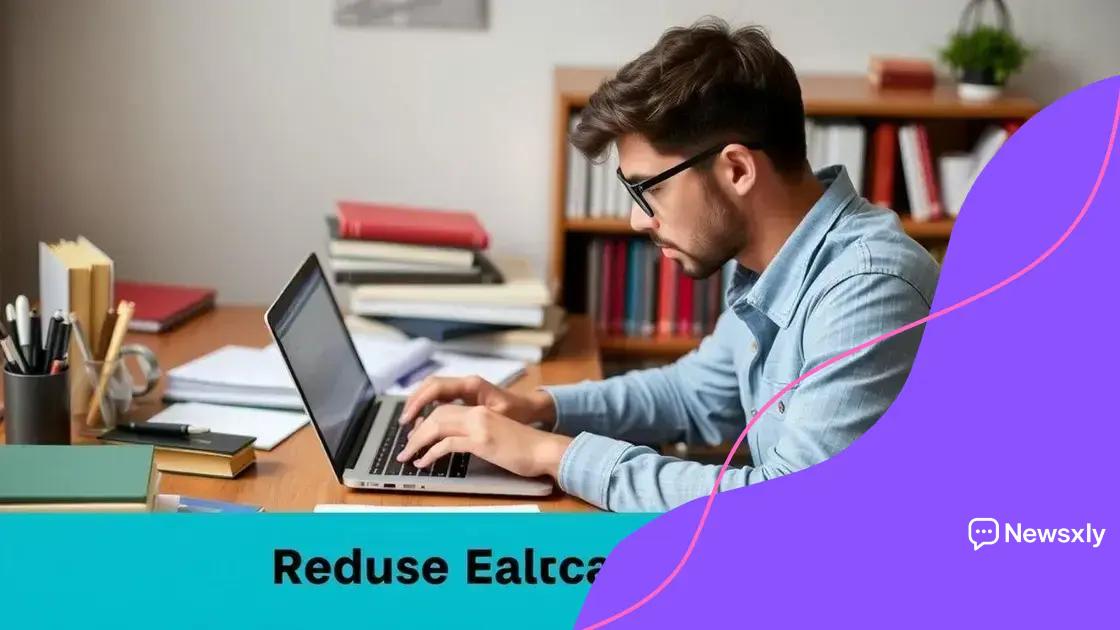College affordability and the student debt crisis explained

College affordability and the student debt crisis can be managed through strategies like loan forgiveness programs, income-driven repayment plans, and applying for scholarships to reduce financial burdens on students.
College affordability and the student debt crisis are pressing issues that affect millions of students nationwide. With rising tuition costs and growing debt, many wonder what solutions are available. Let’s dive into the complexities and find a way forward.
Understanding college affordability
Understanding college affordability is crucial for students today. With tuition costs skyrocketing, many families are concerned about how to pay for higher education. Various factors contribute to these rising costs.
Factors Affecting College Costs
Many elements determine the price tag of a college education. Some factors include:
- The institution type, such as public or private schools.
- Location, which can significantly impact living expenses.
- Demand for programs that can lead to higher tuition.
- Government funding cuts, which can raise costs for students.
Another important point to consider is the role of financial aid. While loans and grants can ease the burden, they also lead to long-term debt issues.
Importance of Researching College Prices
Before selecting a college, research its pricing structure. Are there tuition discounts for in-state residents? Are there opportunities for scholarships? This information can help you make informed decisions.
Many students overlook hidden costs, such as books, supplies, and living expenses. When budgeting for college, it’s vital to account for these additional costs as well.
Budgeting for College
Creating a budget can help manage expenses. Here are some tips:
- Track your monthly income and expenses.
- Identify areas to cut costs, like dining out or subscription services.
- Save for unexpected expenses, such as medical bills or car repairs.
By being aware of these factors and planning ahead, students can tackle the college affordability issue head-on.
The impact of student debt on graduates
The impact of student debt on graduates is profound and often long-lasting. Many young adults enter the workforce burdened by loans, which can shape their financial futures.
Financial Stress and Life Choices
Grads with high levels of debt face significant stress. This pressure can hinder their ability to buy homes, save for retirement, or even travel. When student debt is high, many graduates have to prioritize paying off loans over other life goals.
- Delayed home ownership due to debt obligations.
- Reduced savings for emergencies or retirement.
- Inability to invest in additional education or training.
- Limited job choices as graduates may prioritize higher-paying positions over passion.
This financial strain extends beyond immediate monetary concerns. It can also lead to mental health challenges, as graduates feel overwhelmed by their financial responsibilities.
Impact on Job Choices
The need to pay off student debt can alter career paths for many. Graduates often seek jobs with higher salaries, even if they do not align with their passions. This can lead to dissatisfaction in their careers.
Moreover, recent studies show that many grads with debt are forced to turn down opportunities, such as internships that may not pay well but could provide valuable experience. The job market becomes a balancing act between earning enough to cover debts and pursuing fulfilling careers.
Long-Term Effects
As time passes, the implications of student debt don’t just fade away. Some graduates may still be paying off loans well into their 30s or even 40s. This prolonged debt can influence life decisions, such as marriage and starting a family.
- Graduates may choose to postpone significant life events.
- Debt can strain personal relationships due to financial pressures.
- Long-term financial insecurity can result from delayed savings.
Addressing the impact of student debt on graduates is essential. Understanding these effects can help policymakers and educators make necessary changes to improve future students’ financial outlooks.
Strategies for reducing education costs

Finding strategies for reducing education costs can make a significant difference in managing expenses associated with college. Many students and families feel overwhelmed by tuition fees, but there are options available to help ease this burden.
Understanding Financial Aid
The first step is to explore financial aid options. Many colleges offer scholarships and grants based on merit or need. By filling out the Free Application for Federal Student Aid (FAFSA), students can access multiple sources of financial assistance.
- Check for state grants and scholarships available to residents.
- Research local organizations and foundations that offer educational support.
- Consider federal student loans, which often have lower interest rates.
Moreover, some colleges offer work-study programs allowing students to work part-time while attending classes. This can help pay for daily expenses and reduce overall financial strain.
Choosing Affordable Schools
Another effective strategy is to consider the type of institution. Public colleges typically charge lower tuition rates than private universities. Researching community colleges is also crucial, as they often provide quality education at a fraction of the cost.
Attending a community college can save thousands before transferring to a four-year institution. This path allows students to complete general education requirements at a lower price.
Online Learning Options
Online courses are becoming increasingly popular. These programs often provide flexibility and lower costs than traditional classroom settings. Many universities offer online degrees that can be earned at home.
- Consider online community colleges for added affordability.
- Utilize Massive Open Online Courses (MOOCs) for free or low-cost classes.
- Take advantage of technology that allows learning at your own pace.
By leveraging technology and planning appropriately, students can significantly reduce their education costs and avoid excessive debt.
Government programs addressing the crisis
Government programs addressing the student debt crisis play a crucial role in helping borrowers manage their loans. These initiatives are designed to make higher education more accessible and affordable.
Loan Forgiveness Programs
One major initiative is the loan forgiveness program. This allows eligible borrowers to have part or all of their student loans forgiven after meeting certain requirements. Many programs target specific professions, especially those that serve the community.
- Public Service Loan Forgiveness (PSLF) for teachers and government employees.
- Nursing and healthcare debt forgiveness programs.
- Loan forgiveness for those working in non-profit organizations.
Participating in these programs can significantly relieve financial stress for graduates who dedicate their careers to public service.
Income-Driven Repayment Plans
Another strategy involves income-driven repayment plans. Under these plans, monthly payments are tied to the borrower’s income, making them more manageable. Some plans even offer loan forgiveness after a specific payment period.
Borrowers can choose from several options based on their income and family size, ensuring that repayments are affordable. By easing the burden, these plans give borrowers a sense of financial stability.
Grants and Scholarships
Besides loan forgiveness, government grants and scholarships help minimize the costs of attending college. These funds do not need to be repaid, making them a great option for students.
- Pell Grants for low-income undergraduate students.
- Federal Supplemental Educational Opportunity Grants (FSEOG).
- State-level funding and scholarships to assist residents.
By applying for these grants, students can reduce their reliance on loans and potentially avoid significant debt upon graduation. Understanding these programs is essential for anyone navigating the financial landscape of higher education.
Real-life stories of student debt relief
Real-life stories of student debt relief highlight the possibilities that exist when borrowers seek help. These personal experiences can inspire others struggling with their educational loans.
Case Study: A Teacher’s Journey
One teacher, Sarah, found herself drowning in student loans after finishing her degree. With a passion for education, she started working at a low-paying public school. Through the Public Service Loan Forgiveness program, she learned she could qualify for debt relief after ten years of service.
- Sarah kept track of her payment history and stayed informed about her eligibility.
- She submitted her paperwork regularly to ensure everything was in order.
- After ten years, her remaining balance was forgiven, allowing her to focus on her students instead of her debt.
Stories like Sarah’s show that commitment to public service can lead to substantial relief for those who qualify.
A Nurse’s Experience
Another powerful story comes from Mark, a nurse who struggled with loans after attending nursing school. He worked long hours in a hospital while managing multiple jobs to make ends meet. Mark decided to enroll in an income-driven repayment plan, which adjusted his monthly payments based on his earnings.
This flexible payment option reduced his monthly financial burden significantly. After several years, he also took advantage of a state program that offered loan forgiveness for healthcare workers in underserved areas.
- Mark stayed updated on his income-driven plan to ensure he benefited fully.
- He reached out for help when he needed guidance on available state programs.
- Through dedication and informed choices, Mark achieved a manageable debt level.
These real-life stories showcase the impact of understanding available programs and taking strategic steps in managing student debt.
In summary, addressing the student debt crisis requires understanding available options and actively participating in programs designed to help. From loan forgiveness initiatives to income-driven repayment plans, there are pathways to alleviate the burden of student loans. Real-life stories show that with effort and a bit of guidance, many can navigate through school costs and manage their debts successfully. As students and graduates explore their choices, it’s vital to stay informed and seek support, ensuring a brighter financial future.
FAQ – Common Questions about Student Debt Relief
What is the Public Service Loan Forgiveness program?
The Public Service Loan Forgiveness program forgives the remaining balance of your Direct Loans after you have made 120 qualifying monthly payments while working full-time for a qualifying employer.
How can income-driven repayment plans help borrowers?
Income-driven repayment plans adjust your monthly student loan payments based on your income and family size, making payments more manageable and helping avoid default.
Are there scholarships available for reducing education costs?
Yes, there are numerous scholarships available that do not need to be repaid, including those based on merit, need, or specific fields of study.
How can I stay informed about student debt relief options?
You can stay informed by visiting government websites, following related organizations on social media, and attending workshops or webinars focused on student debt management.





